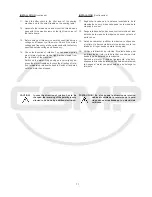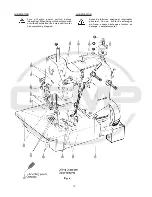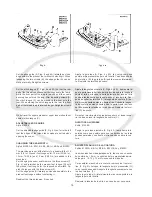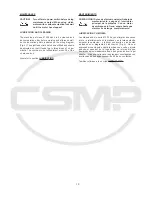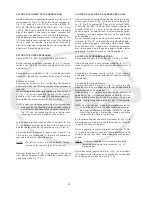
24
Rotate handwheel in operating direction until the upper
spreader is in its extreme right lower end position. The upper
spreader should not contact any machine parts during its
motion.
If required loosen clamp screw (D, Fig. 12) in the drive
lever (E) and set the lever so that the upper spreader (F)
clears at all points. Retighten clamp screw (D).
After this setting recheck the position of the upper spreader
to the needle, as described above. Reset with connecting
rod (C, Fig. 12) if required and tighten nuts (L and R).
Rotate handwheel in operating direction. On the upward
travel of the upper spreader (B, Figs. 13 and 13 A) the tip
of its lower prong (G) must pass as close as possible in
the recess behind the eye of the lower looper (A, Fig. 13),
respectively in the recess on lower spreader (A, Fig. 13 A)
without contacting it.
If an adjustment is required, loosen nut (G, Fig. 7) and
swing the looper lever with lower looper accordingly to the
right or left. Retighten nut (G).
CAUTION!
Check the setting of the needle bar height after
making this adjustment and reset if required.
Refer to paragraph
SETTING THE HEIGHT
OF THE NEEDLE BAR
.
SETTING THE UPPER LOOPER
Style 81500C
Preliminary mount the upper looper (A, Fig. 11 B) and the
thread hook (B) to the looper shank (S) so that the distance
(T) between upper looper and thread hook is as big as
possible.
For adjustment of upper looper (A, Fig. 11 B) with respect
to the needle (N) the looper shank (S) has two offsett flats.
Proceed as follows:
First snug one screw (C, Fig. 11 B) on the flat of looper
shank (S) with which the following position of the upper
looper is reached:
When rotating the handwheel in operating direction, upper
looper (A, Fig. 11 C) should pass with its face (D) as close
as possible to the front of needle (N), without contacting it.
Now tighten the second screw (C, Fig. 11 B) firmly.
For precise adjustment of upper looper (A, Fig. 11 C) with
respect to the needle (N) loosen screws (U) and set the
upper looper (A) accordingly.
Simultaneously set the thread hook (B, Fig. 11 C) so that
its tip passes close behind the needle (N) without contacting
it. Retighten the two screws (U).
HINT: In case the adjusting possibility of the upper looper
as described is not sufficient, additionally the bearing
(A, Fig. 12) can be moved slightly up or down when
loosening the two screws (B). Retighten screws.
Gire el volante en dirección de operación hasta que el
spreader superior esté en su posición extrema inferior. El
spreader superior no debe tocar ninguna parte de la máqui-
na durante esta operación.
Si es necesario, afloje el tornillo de sujeción (D, Fig. 12) en
la palanca (E) y ajústela de manera tal que el spreader su-
perior (F) no toque ninguna otra pieza. Apriete el tornillo de
sujeción (D).
Después de realizar este ajuste, verifique la posición del
spreader superior con la aguja, tal y como se describe en el
párrafo anterior. Reajuste con la barra de conexión (C, Fig.
12) de ser necesario y apriete de nuevo las tuercas (L y R) .
Gire el volante en dirección de operación. En la extrema
superior de su recorrido, la punta inferior (C) del spreader
superior (B, Fig. 13 y 13 A) debería pasar lo mas cerca
posible del espacio detrás del ojo del looper inferior (A, Fig.
13) respectivamente en el espacio del spreader inferior (A,
Fig. 13 A) pero sin tocarlo.
De ser necesario un ajuste, suelte la tuerca (G, Fig. 7) y
mueva la palanca del looper hacia la derecha o izquierda,
como sea necesario. Reajuste la tuerca (G) nuevamente.
PRECAUCION!
Revise la altura de la barra de aguja des-
pués de realizar estos ajustes y reajuste de ser
necesario. Refiérase al párrafo
AJUSTE DE
LA ALTURA DE LA BARRA DE AGUJA
.
AJUSTE DEL LOOPER SUPERIOR
Estilo 81500C
Monte el looper superior (A, Fig. 11 B) y el gancho de hilo
(B) en el tronco del looper (S), de manera que la distancia
(T) entre el looper superior y el gancho de hilo sea tan gran-
de como posible.
Para ajustar el looper superior (A, Fig. 11B) con respecto
a la aguja (N) el tronco del looper (S) tiene dos superficies
planas.
Proceda de la siguiente manera:
Primero acomode un tornillo (C, Fig. 11B) contra la parte
plana del tronco del looper (S) , con lo cual se alcanzará la
siguiente posición del looper:
Cuando se gire el volante en dirección de operación, el
looper (A, Fig. 11CA) debe pasar con su cara (D) tan cer-
ca como sea posible por delante de la aguja (N) pero sin
tocarla. Ajuste el segundo tornillo (C), Fig. 11B) firmemen-
te.
Para un ajuste preciso del looper superior (A, Fig. 11 C)
con respecto a la aguja (N) suelte los tornillos (U) y ajuste
el looper superior (A) como sea necesario.
Simultáneamente ajuste el gancho del hilo (B, Fig. 11 C)
de manera que su punta pase lo mas cerca posible detrás
de la aguja (N) pero sin tocarla. Apriete los dos tornillos
(U).
DATO: En el caso de que el ajuste descrito del looper su-
perior no sea suficiente, se recomienda mover el ro-
damiento del looper (A, Fig. 12) ligeramente hacia
arriba o hacia abajo, después de haber soltado los
tornillos (B). Apriete los tornillos.
Содержание 81500A
Страница 8: ...8 INSTALLATION INSTALACION ...
Страница 10: ...10 ...
Страница 21: ...21 ...
Страница 23: ...23 Fig 10 Fig 11 Fig 11 A Fig 11 B Fig 11 C Fig 12 ...
Страница 25: ...25 ...
Страница 28: ...28 ...
Страница 33: ...33 VIEWS AND DESCRIPTION OF PARTS VISTAS Y DESCRIPCIONES DE LAS PARTES Y PIEZAS ...
Страница 34: ...34 ...
Страница 36: ...36 ...
Страница 38: ...38 ...
Страница 40: ...40 ...
Страница 42: ...42 ...
Страница 44: ...44 ...
Страница 46: ...46 ...
Страница 48: ...48 ...
Страница 50: ...50 ...
Страница 52: ...52 ...
Страница 54: ...54 ...
Страница 56: ...56 ...
Страница 58: ...58 ...
Страница 60: ...60 ...
Страница 62: ...62 ...
Страница 64: ...64 ...
Страница 68: ......


